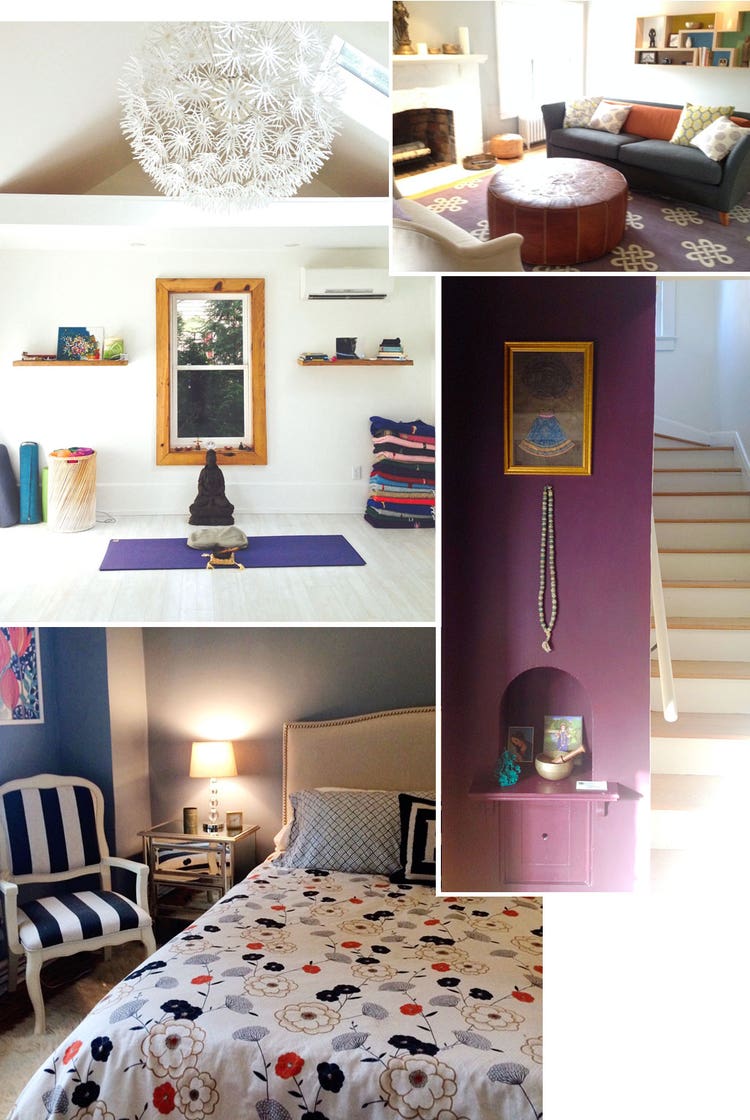Change Your Space, Change Your Life

Refresh your living space to restore energy and inspiration.
Oscar Wilde famously stated, “Life imitates art far more than art imitates life.” For New York City interior designer and sacred space stylist Elana Kilkenny, this is true more often than not.
The look, feel and placement of objects within a client’s home, she says, speaks volumes about his or her state of mind. Likewise, she says, the simple act of changing your space can spark joy and serve as a catalyst for personal growth.
“I look at the home as a living organism,” Kilkenny says. “It reflects back to the stories of your life.” Change the story it’s telling, she says, and you can create better conditions in which to thrive. “We spend so much energy working on our bodies and our health, but often our homes are neglected.”
Here’s how she works with clients to revamp their environment, along with some of her best tips for creating a space that feels nurturing and inspiring.

Establishing your home’s story
Kilkenny calls her work sacred space design — not because it has any religious aspect, but because she wants to make a home a true reflection of the owner and what he or she loves, desires or values — a “tapestry” of past and present experiences, as well as dreams for the future.
“You can have a beautifully designed home, but it might be telling the wrong story,” she says, particularly if it’s filled with cast-offs you didn’t really want, or art and furniture that reflects a different stage of your life.
Kilkenny’s work is a culmination of her degree in psychology from New York University, training in feng shui, love of interior design and a sabbatical she took from her publishing job to visit healers around the world.
“I realized that my interests lie in the dynamics between people.”
While other interior designers get clients who want to “refresh” their home’s decor, Kilkenny’s clients are often grappling with some big issue or transition, such as a getting married or divorced, adjusting to life as an empty nester or hitting a plateau in their career.
“They have a sense that their home is not a nourishing place for them,” she says.
One client, who was referred by his therapist, was having trouble committing to a serious relationship. His oppressive relationship with his father and strained relationships with the rest of his family were telegraphed in the stark white space and the oversized pieces of art he had chosen for his home, Kilkenny said, with paintings of people staring or watching, that seemed to loom over seating areas.
“You didn’t feel comfortable to linger or feel at ease. And that’s how he felt in his own body,” she said.
In conjunction with his therapy, Kilkenny helped him soften and warm up his décor, and get more comfortable with imperfection, including getting him to have one messy drawer in his bedroom that he was supposed to meditate on daily. That client, she says, is now married.
Another was holding on to the furniture, art and other remnants of an old marriage that no longer served her. She had lost touch with what she really liked or wanted. Kilkenny gave her some strategies to get in touch with what she liked and change her bedroom to better reflect who she was now, including choosing new art that symbolized what she wanted to feel in a new relationship, which she ultimately found.
Sometimes, it’s just about finding inspiration for a new stage in life. Kilkenny helped one client who was about to become an empty-nester “rediscover her own voice outside of being a parent” and make bolder choices in color, design and art that would give her greater confidence in expressing herself, networking and establishing a new business.
Creating your own sacred space
A good place to start in creating your own sacred space is to walk through your home and examine it with a fresh set of eyes.
Kilkenny recommends walking in through the front door as if you’re a stranger, taking a different route than you normally would through the house, and noticing what your eye is drawn to and why. Take notes about what you see and how you feel, particularly what emotions surface in certain areas. Ask yourself these focusing questions:
- What areas are calling out for change?
- Does the flow of your home allow you to move through it easily? Does the furniture placement work? If the bed was in a different position, would you sleep better?
- Does the style of your home and the things within it reflect who you are now and the life you desire to live?
- What are you longing for, but don’t see in your home?
- Does your art speak to your heart and inspire you?
- Is clutter a problem?
- Does your home have a good balance of things that are symbolic of your past, present and future?
- How do the colors and textures make you feel?
Then, she says, start to prioritize. Choose at least one thing to change, using visual inspiration from Pinterest and other sites to begin establishing the style that speaks to you and the common elements that you love.
“Ask yourself,” Kilkenny says, “what does home mean for me?” It doesn’t have to be design-magazine perfect, but you do have to love what you are creating, and it does have to work well for you. Consider this process, she says, a sort of reconnecting to the “home” within you.
“As you change your space,” she says, “you change your life.”
Elana Kilkenny’s Five Steps to Make Your Home a Sacred Space
01 Balance the past, present and future in the design of your home.
Your home should remind you of who you were, who you are now and who you are becoming. Take a look at the items in your home such as photographs, furniture and decorative items, and notice if you have too many things from a certain time in your life. There is a benefit to your heart and soul in personalizing your space, and having the decoration and feel of your home integrate your past, nourish your present and inspire your future.
02 Choose artwork that is symbolic of what you love and what you want to grow in your life.
Look at the art in your home and ask yourself if the feeling, memory or story it evokes is a positive one or if it’s reflective of patterns, situations or emotions that are challenging, draining or unhappy for you.
03 Clear the clutter.
Clearing out clutter not only makes it easier to navigate your home and find things, it enhances its beauty and has a positive effect on your emotions, health and energy levels. It can clear the way for unexpected magic, synchronicity and abundance in your life.
04 Honor your dreams, goals and intentions with home altars.
A very powerful way to create sacred space in your home is to find a nook or corner in your home and fill it with that which is sacred to you. Consider this space a three-dimensional vision board for you to focus, attract and actualize your desires.
05 Pay attention to your bedroom.
Many people, particularly parents, put energy into decorating the front of their homes, but neglect their bedroom. The bedroom can be a haven for you to move away from all of the stress in your life, to slow down, savor, rejuvenate and sensualize. Keep out distractions and stress amplifiers such as bills, work files, piles of clutter and too much technology. Think about how you want to feel in your bedroom, and let that guide you in its design. If you have a partner who shares this space with you, make sure to include him or her into the design process so that the space reflects both of you.
Find out more about Elana Kilkenny’s sacred space design:
- Instagram: Instagram.com/sacredhomedesign
- Pinterest: pinterest.com/elanakilkenny
- Facebook: Facebook.com/elanakilkenny